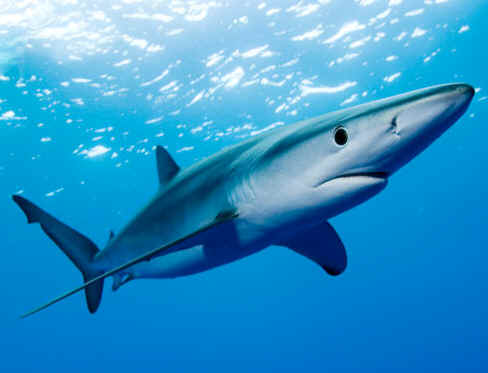Habitat preferences and migratory patterns of the blue shark (Prionace glauca) in the Northern Atlantic Ocean
Lucy Howey & Mahmood Shivji – Guy Harvey Research Institute, Oceanographic Center, Nova Southeastern University
Brad Wetherbee – Department of Biological Sciences, University of Rhode Island
 The blue shark (Prionace glauca) is a highly migratory, pelagic, circumglobally distributed species whose fins constitute by far the largest proportion of fins traded in the in the world market. Despite its highly exploited status, relatively little is known about the complex and likely sexually-biased, long-term or short-term movement patterns of this species. Conventional tagging and observational data indicate that blue sharks are common off the coast of the northeastern US during the summer months May-September. To investigate the short-term environmental preferences of blue sharks on the continental shelf off the northeastern US during summer months, PTT-100 archival, High Rate archival and X-tags (Microwave Telemetry) were fitted to seven individuals in June 2007. The tags recorded depth, temperature, and light data at either 3 or 15 minute intervals. A total of 104 days of data was archived. Of the seven sharks tagged (males=5, females=2). Sharks spent a large proportion (79.5%) of time within 10 m of the surface with infrequent dives to greater depths; average depth for females was 3.2 m and for males, 6.8 m. One shark, which retained its tag for 6 weeks, exhibited more frequent diving behavior and traveled a distance of 341.2 km between tag deployment and tag release locations, however it predominantly remained on the continental shelf.
The blue shark (Prionace glauca) is a highly migratory, pelagic, circumglobally distributed species whose fins constitute by far the largest proportion of fins traded in the in the world market. Despite its highly exploited status, relatively little is known about the complex and likely sexually-biased, long-term or short-term movement patterns of this species. Conventional tagging and observational data indicate that blue sharks are common off the coast of the northeastern US during the summer months May-September. To investigate the short-term environmental preferences of blue sharks on the continental shelf off the northeastern US during summer months, PTT-100 archival, High Rate archival and X-tags (Microwave Telemetry) were fitted to seven individuals in June 2007. The tags recorded depth, temperature, and light data at either 3 or 15 minute intervals. A total of 104 days of data was archived. Of the seven sharks tagged (males=5, females=2). Sharks spent a large proportion (79.5%) of time within 10 m of the surface with infrequent dives to greater depths; average depth for females was 3.2 m and for males, 6.8 m. One shark, which retained its tag for 6 weeks, exhibited more frequent diving behavior and traveled a distance of 341.2 km between tag deployment and tag release locations, however it predominantly remained on the continental shelf.
Mean water temperature occupied was 16.3 oC and ranged from 7.7 oC to 22.5 oC with few dives through the thermocline. No diel patterns associated with diving were observed for either depth or water temperature. The limited movements of blue sharks within a very narrow portion of the water column in the upper mixed layer on the continental shelf of the US east coast may be related to mating behavior or feeding behavior, both of which vary seasonally. We have deployed additional satellite tags to further investigate the migratory and diving behavior of this species over longer time periods and will report on those findings soon.
This project was aided tremendously by the sport fishing charter SEAKER
 Home
Home Browse
Browse Close
Close Events
Events Maps
Maps Email
Email Brightspace
Brightspace eCampus
eCampus



